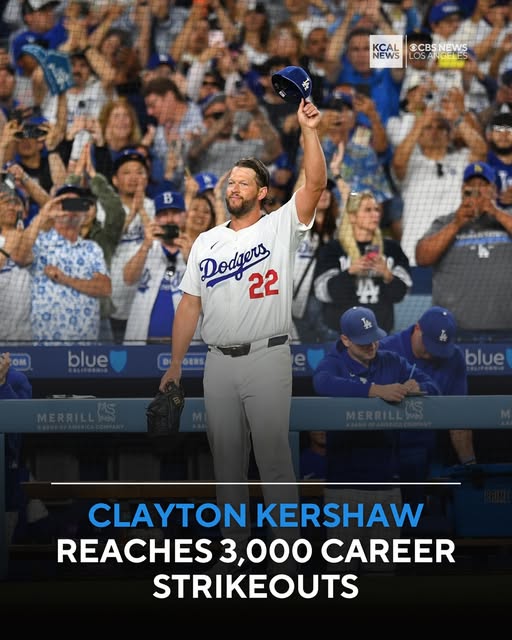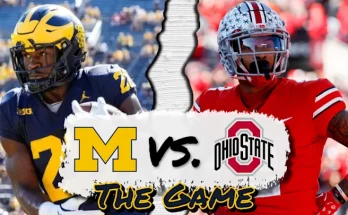In a moment that will forever be etched in baseball history, Clayton Kershaw, the Los Angeles Dodgers’ ace and one of the game’s most dominant pitchers of the modern era, achieved a milestone that only a select few have ever reached. On a bright summer night, facing off against the Chicago White Sox, Kershaw struck out a batter to notch his 3,000th career strikeout, joining an exclusive club that immortalizes the most lethal strikeout artists in Major League Baseball history. This achievement not only underscores Kershaw’s longevity and excellence but also places him among the pantheon of pitching legends who have shaped the sport for generations.
Reaching 3,000 strikeouts is no small feat in the realm of baseball. Since the inception of Major League Baseball, only a handful of pitchers have managed to amass this many strikeouts, a testament to both their skill and durability. Strikeouts, often regarded as the ultimate display of a pitcher’s dominance over a hitter, require precision, strategy, and an ever-evolving arsenal of pitches. For Kershaw, a pitcher known for his devastating curveball, pinpoint control, and mental toughness, the milestone is a reflection of his consistency and ability to adapt across more than a decade of competition at the highest level.
Kershaw’s journey to this milestone began long before he stepped onto the mound that night. Drafted by the Dodgers as the seventh overall pick in the 2006 MLB Draft, he quickly made waves with his talent and work ethic. His MLB debut in 2008 showcased flashes of brilliance, but it was in the following years that he truly cemented himself as one of the premier pitchers in the game. Winning multiple Cy Young Awards, leading the National League in ERA several times, and earning MVP honors, Kershaw’s resume reads like that of a future Hall of Famer. Yet, this 3,000-strikeout milestone was a benchmark he and fans had been anticipating, a moment that marks not just his excellence but also his place in history.
The game against the White Sox was charged with energy as fans, teammates, and commentators alike waited in anticipation. Kershaw had already been dominant on the mound, mixing his pitches expertly, keeping hitters off balance, and showcasing the skill and experience that have defined his career. When he struck out the batter to reach 3,000, the stadium erupted in celebration, recognizing the magnitude of what had just transpired. For the Dodgers organization and their passionate fan base, it was a proud moment, a confirmation that one of their all-time greats had ascended to a level of greatness that few achieve.
What makes Kershaw’s milestone even more remarkable is the context of his career. Unlike some strikeout pitchers who rely solely on velocity, Kershaw’s approach has been a masterclass in finesse, strategy, and control. His signature curveball, often described as one of the best in baseball history, combined with a fastball that can reach the mid-90s, has kept hitters guessing for years. More importantly, Kershaw’s ability to adjust and evolve as the game changes has allowed him to maintain elite performance, even as he has aged and faced new generations of hitters. This adaptability is a hallmark of true greatness and one that has helped him compile not just strikeouts, but wins, accolades, and respect.
Joining the 3,000-strikeout club is a rare honor shared by pitchers such as Nolan Ryan, Randy Johnson, and Roger Clemens—names synonymous with power, longevity, and dominance. Kershaw’s addition to this group signals a continuation of baseball’s rich history, linking the past with the present. It also serves as a reminder of how the game has evolved and how Kershaw has managed to stay ahead of trends and competition. As baseball increasingly leans into analytics and shifting offensive strategies, Kershaw’s success is a testament to traditional pitching mastery combined with modern adaptability.
Beyond the numbers and records, Kershaw’s milestone has a deeper significance for fans and players alike. It represents the culmination of years of dedication, sacrifice, and passion. For young pitchers aspiring to reach the majors, Kershaw’s journey offers a blueprint for success: relentless work ethic, continuous learning, and the mental resilience to overcome adversity. His career has been marked by moments of triumph and challenges, including injuries and playoff heartbreaks, yet his ability to bounce back and perform at an elite level has inspired many.
The Dodgers organization, with its rich history and commitment to excellence, has been the perfect home for Kershaw to flourish. His leadership on and off the field has been invaluable, helping guide a new generation of players while maintaining a culture of winning. The 3,000-strikeout achievement is not just a personal milestone but also a chapter in the Dodgers’ ongoing story of success. It highlights the importance of player development, perseverance, and the pursuit of greatness that defines the franchise.
Media and analysts quickly recognized the significance of Kershaw’s milestone. Commentators praised his ability to dominate hitters across eras, noting how few pitchers maintain such high levels of performance for so long. Baseball historians pointed out the rarity of reaching 3,000 strikeouts without the overpowering velocity that many modern pitchers rely on, emphasizing Kershaw’s cerebral approach to the game. His accomplishment sparked conversations about his place among the all-time great pitchers and increased the anticipation of his eventual induction into the Baseball Hall of Fame.
For the White Sox, being part of this historic moment was bittersweet. Facing one of the greatest pitchers of the generation meant tough at-bats and few opportunities to break through offensively. However, the respect paid to Kershaw by the opposing team and its fans underscored the universal admiration for his career and the milestone he achieved. Baseball is a sport rich in tradition and respect, and moments like these transcend rivalries, uniting players and fans in celebration of the game’s greatest achievements.
Looking ahead, the 3,000-strikeout milestone is not just a finish line but a new chapter for Kershaw. It serves as a motivator to continue pitching at a high level, contributing to his team’s success, and chasing further records. While some players slow down after reaching major career milestones, Kershaw has shown no signs of slowing, continuing to refine his craft and compete fiercely. His focus now includes mentoring younger pitchers, passing on knowledge, and remaining a key figure in the Dodgers’ rotation as they chase championships.
The historical weight of this accomplishment also resonates within the larger narrative of baseball’s evolution. Pitching, once dominated by brute force and raw velocity, has increasingly emphasized technique, analytics, and pitch sequencing. Kershaw’s milestone embodies this shift, highlighting how success at the highest level often requires intelligence and adaptability as much as physical prowess. As the sport continues to evolve, Kershaw’s career offers valuable lessons on balancing talent with strategy, making him a role model for the next generation of pitchers.
Fans across the country, from young children playing catch in their backyards to longtime devotees of the game, have celebrated Kershaw’s milestone. It’s a moment that inspires pride in baseball’s rich heritage and excitement for its future. Social media buzzed with tributes, highlight reels, and personal stories of how Kershaw has influenced people’s love of the game. For many, this achievement is more than just a statistic—it’s a symbol of perseverance, excellence, and the timeless joy of baseball.



